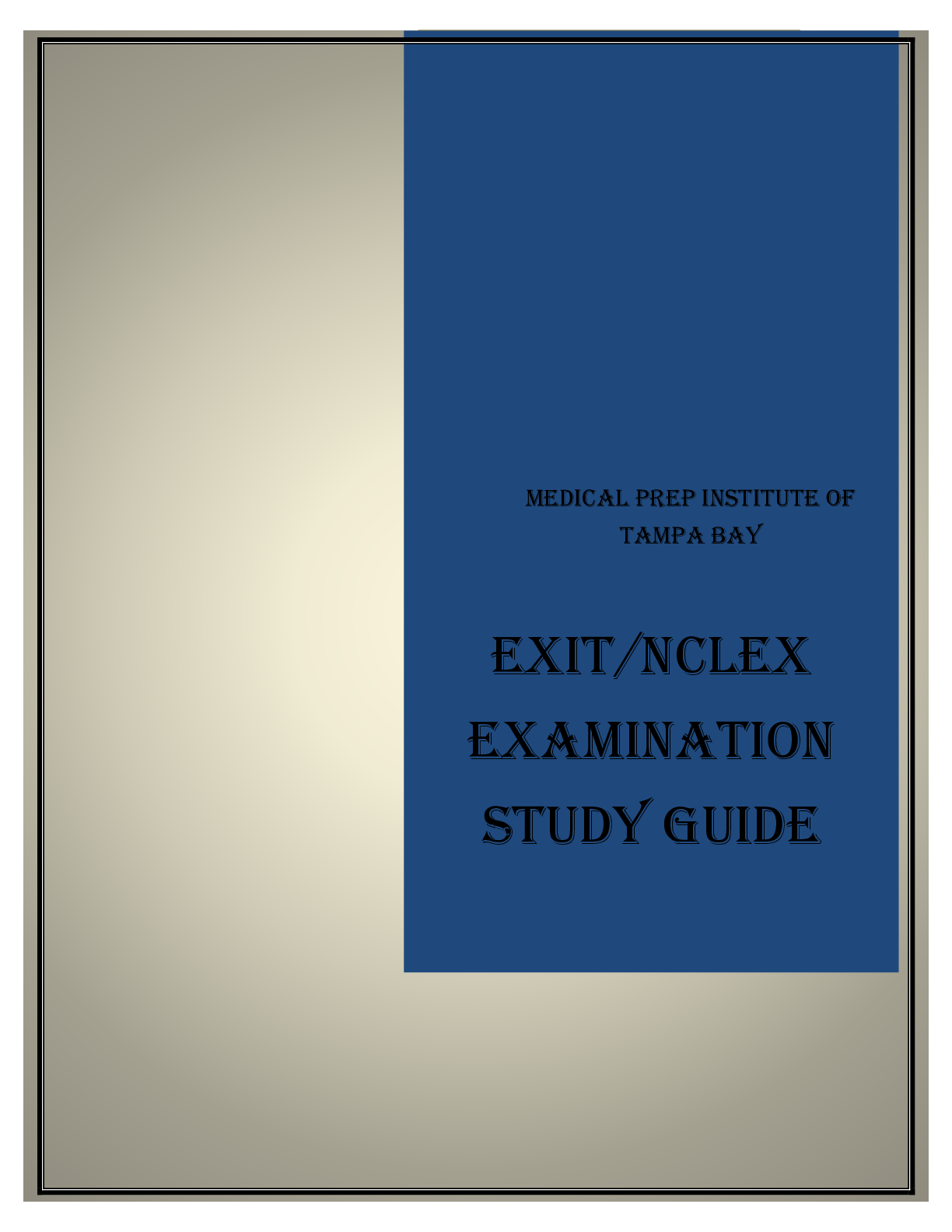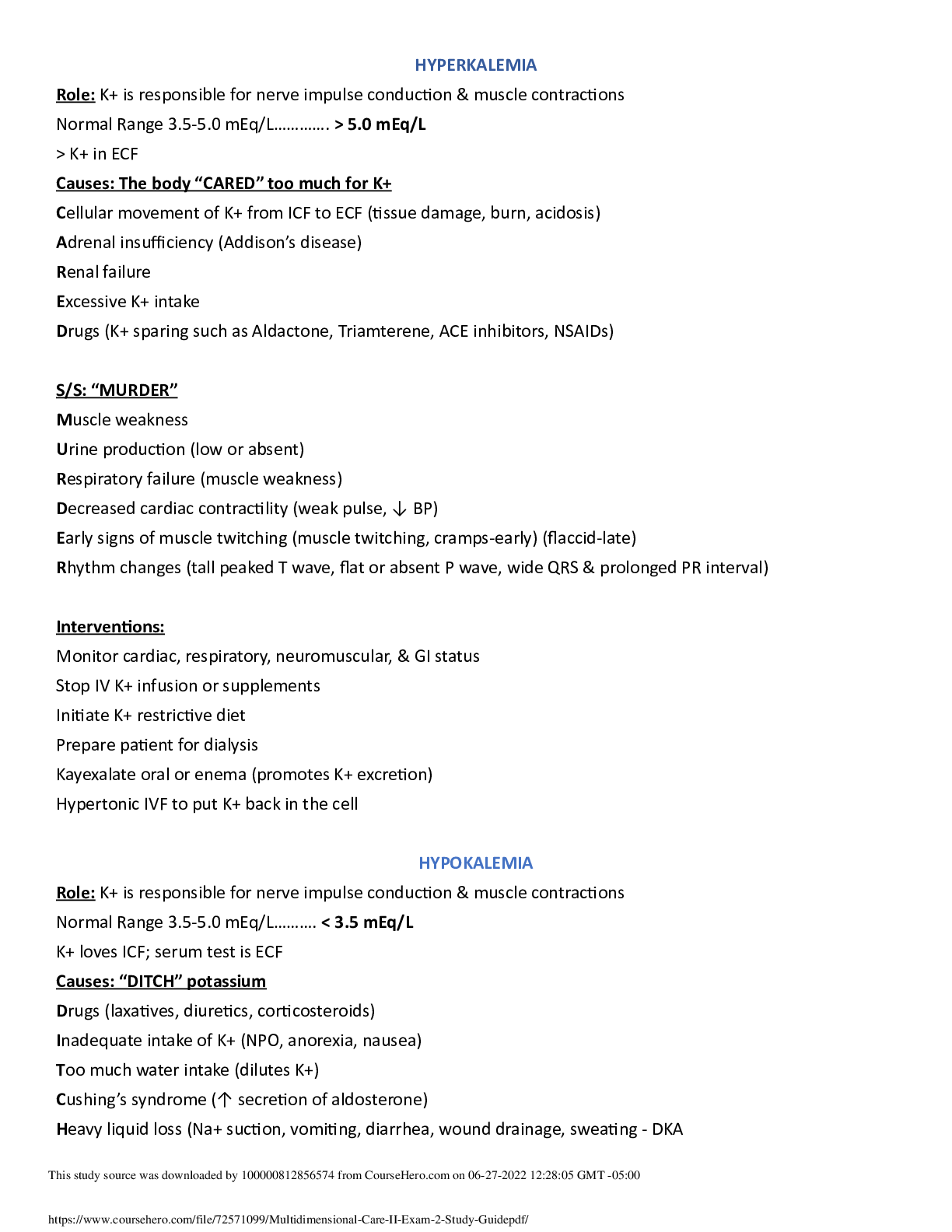Business > STUDY GUIDE > Pennsylvania State UniversityACCTG 560hca14_SM_CH20-INVENTORY MANAGEMENT, JUST-IN-TIME, AND SIMPLIFI (All)
Pennsylvania State UniversityACCTG 560hca14_SM_CH20-INVENTORY MANAGEMENT, JUST-IN-TIME, AND SIMPLIFIED COSTING METHODS
Document Content and Description Below
CHAPTER 20 INVENTORY MANAGEMENT, JUST-IN-TIME, AND SIMPLIFIED COSTING METHODS 20-1 Cost of goods sold (in retail organizations) or direct materials costs (in organizations with a manufacturing fun... ction) as a percentage of sales frequently exceeds net income as a percentage of sales by many orders of magnitude. In the Kroger grocery store example cited in the text, cost of goods sold to sales is 76.8%, and net income to sales is 0.1%. Thus, a 10% reduction in the ratio of cost of goods sold to sales (76.8 to 69.1% equal to 7.7%) without any other changes can result in a 7800% increase in net income to sales (0.1% plus 7.7% equal to 7.8%). 20-2 Six cost categories important in managing goods for sale in a retail organization are the following: 1. purchasing costs; 2. ordering costs; 3. carrying costs; 4. stockout costs; 5. costs of quality; and 6. shrinkage costs 20-3 Five assumptions made when using the simplest version of the EOQ model are: 1. The same quantity is ordered at each reorder point. 2. Demand, ordering costs, carrying costs, and the purchase-order lead time are certain. 3. Purchasing cost per unit is unaffected by the quantity ordered. 4. No stockouts occur. 5. Costs of quality and shrinkage costs are considered only to the extent that these costs affect ordering costs or carrying costs. 20-4 Costs included in the carrying costs of inventory are incremental costs for such items as insurance, rent, obsolescence, spoilage, and breakage plus the opportunity cost of capital (or required return on investment). 20-5 Examples of opportunity costs relevant to the EOQ decision model but typically not recorded in accounting systems are the following: 1. the return forgone by investing capital in inventory; 2. lost contribution margin on existing sales when a stockout occurs; and 3. lost contribution margin on potential future sales that will not be made to disgruntled customers. 20-6 The steps in computing the costs of a prediction error when using the EOQ decision model are: Step 1: Compute the monetary outcome from the best action that could be taken, given the actual amount of the cost input. Step 2: Compute the monetary outcome from the best action based on the incorrect amount of the predicted cost input. Step 3: Compute the difference between the monetary outcomes from Steps 1 and 2.20-2 20-7 Goal congruence issues arise when there is an inconsistency between the EOQ decision model and the model used for evaluating the performance of the person implementing the model. For example, if opportunity costs are ignored in performance evaluation, the manager may be induced to purchase in a quantity larger than the EOQ model indicates is optimal. 20-8 Just-in-time (JIT) purchasing is the purchase of materials (or goods) so that they are delivered just as needed for production (or sales). Benefits include lower inventory holdings (reduced warehouse space required and less money tied up in inventory) and less risk of inventory obsolescence and spoilage. 20-9 Factors causing reductions in the cost to place purchase orders of materials are: Companies are establishing long-run purchasing agreements that define price and quality terms over an extended period. Companies are using electronic links, such as the Internet, to place purchase orders. Companies are increasing the use of purchase-order cards. 20-10 Disagree. Choosing the supplier who offers the lowest price will not necessarily result in the lowest total purchase cost to the buyer. This is because the price or purchase cost of the goods is only one—and perhaps, most obvious—element of cost associated with purchasing and managing inventories. Other relevant cost items are ordering costs, carrying costs, stockout costs, quality costs, and shrinkage costs. A low-cost supplier may well impose conditions on the buyer—such as poor quality, or frequent stockouts, or excessively high inventories—that result in high total costs of purchase. Buyers must examine all the elements of costs relevant to inventory management, not just the purchase price. 20-11 Supply-chain analysis describes the flow of goods, services, and information from the initial sources of materials and services to the delivery of products to consumers, regardless of whether those activities occur in the same company or in other companies. Sharing of information across companies enables a reduction in inventory levels at all stages, fewer stockouts at the retail level, reduced manufacture of product not subsequently demanded by retailers, and a reduction in expedited manufacturing orders. 20-12 Just-in-time (JIT) production is a “demand-pull” manufacturing system that has the following features: Organize production in manufacturing cells, Hire and retain workers who are multi-skilled, Aggressively pursue total quality management (TQM) to eliminate defects, Place emphasis on reducing both setup time and manufacturing cycle time, and Carefully select suppliers who are capable of delivering quality materials in a timely manner. 20-13 Traditional normal and standard costing systems use sequential tracking, in which journal entries are recorded in the same order as actual purchases and progress in production, typically at four different trigger points in the process. Backflush costing omits recording some of the journal entries relating to the cycle from purchase of direct materials to sale of finished goods, i.e., it has fewer trigger points at which journal entries are made. When journal entries for one or more stages in the cycle are omitted,20-3 the journal entries for a subsequent stage use normal or standard costs to work backward to “flush out” the costs in the cycle for which journal entries were not made. 20-14 Versions of backflush costing differ in the number and placement of trigger points at which journal entries are made in the accounting system: Number of Journal Entry Trigger Points Location in Cycle Where Journal Entries Made Version 1 3 Stage A. Purchase of direct materials and incurring of conversion costs Stage C. Completion of good finished units of product Stage D. Sale of finished goods Version 2 2 Stage A. Purchase of direct materials and incurring of conversion costs Stage D. Sale of finished goods Version 3 2 Stage C. Completion of good finished units of product Stage D. Sale of finished goods 20-15 Traditional accounting systems cost individual products, and separate product costs from selling, general, and administrative costs. Lean accounting costs the entire value stream instead of individual products. Rework costs, unused capacity costs, and common costs that cannot be reasonably assigned to value streams are excluded from value stream costs. In addition, many lean accounting systems expense material costs the period they are purchased, rather than storing them on the balance sheet until the products using the material are sold. 20-16 (20 min.) Economic order quantity for retailer. 1. D = 10,000 jerseys per year, P = $200, C = $7 per jersey per year 7 2 10,000 $200 C 2 DP EOQ = 755.93 756 jerseys 2. Number of orders per year = EOQ D = 756 10,000 = 13.22 14 orders 3. working day Demand each = Number [Show More]
Last updated: 2 years ago
Preview 1 out of 24 pages

Buy this document to get the full access instantly
Instant Download Access after purchase
Buy NowInstant download
We Accept:

Reviews( 0 )
$11.00
Can't find what you want? Try our AI powered Search
Document information
Connected school, study & course
About the document
Uploaded On
Jun 09, 2021
Number of pages
24
Written in
Additional information
This document has been written for:
Uploaded
Jun 09, 2021
Downloads
0
Views
45













